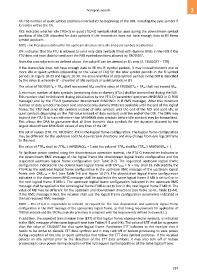Page 807 - 5G Basics - Core Network Aspects
P. 807
Transport aspects 2
TA: the number of quiet symbol positions inserted at the beginning of the DOI, including the sync symbol if
it resides within the TA.
TIQ: indicates whether idle (TIQ=1) or quiet (TIQ=0) symbols shall be used during the downstream symbol
positions of the DOI allocated for data symbols if the transceiver does not have enough data to fill these
symbol positions.
NOTE – No TIQ value is defined for the upstream direction since idle and quiet symbols are identical.
IDF: indicates that the FTU is allowed to send only data symbols filled with dummy DTUs in the NOI if the
FTU does not have data to send over the NOI symbol positions allowed by TBUDGET.
From the control primitives defined above, the value B' can be derived as B'= max (0, TBUDGET − TTR).
If the transceiver does not have enough data to fill the B' symbol periods, it may instead transmit one or
more idle or quiet symbols (depending on the value of TIQ) for the later symbol periods in the B' symbol
periods. In Figure 10-29 and Figure 10-30, the actual number of data symbol periods in the DOI is identified
by the value B, where B= B' − (number of idle symbols or quiet symbols in B').
The value of TBUDGETds + TAds shall not exceed Mds and the value of TBUDGETus + TAus shall not exceed Mus.
A minimum number of data symbols (containing data or dummy DTUs) shall be transmitted during the NOI.
This number shall be indicated during initialization by the FTU-O (parameter upstream MNDSNOI in O-PMS
message) and by the FTU-R (parameter downstream MNDSNOI in R-PMS message). After this minimum
number of data symbols has been sent and once only dummy DTUs are available until the end of the logical
frame, the FTU shall send idle symbols instead of data symbols until the end of the NOI and send idle or
quiet symbols depending on the TIQ value instead of data symbols until the end of the DOI. The DRA may
instruct the FTU-O to transmit more than MNDSNOI data symbols before idle symbols may be transmitted.
This allows the DRA to guarantee that all lines transmit data symbols for the duration dictated by the
largest downstream MNDSNOI values of any lines of the DP.
The set of values {TTR, TA, TBUDGET, IDF} is the logical frame configuration. The logical frame configuration
may be different for the upstream and the downstream directions and may change from one logical frame
to the next.
The value of TTRds shall be TTRds ≥ MNDSNOIds + 1 and the value of TTRus shall be TTRus ≥ MNDSNOIus + 1.
To facilitate power control using the discontinuous operation interval, the FTU-O transmitter indicates in
the downstream RMC message of the logical frame the downstream logical frame configuration and the
requested upstream logical frame configuration (see Table 9-7). The requested upstream logical frame
configuration indicated in the downstream logical frame with CNTLF,ds = N + MSF shall be indicated by the
FTU-R as the upstream logical frame configuration in the upstream RMC message of the upstream logical
frame with CNTLF,us = N+1 (see Table 9-8 and Figure 10-27). The downstream logical frame configuration
indicated in the downstream RMC message shall be applied in the same logical frame if MB is set to 0 or in
the next logical frame if MB=1. The upstream logical frame configuration indicated in the upstream RMC
message shall be applied in the same logical frame if MB is set to 0 or in the next logical frame if MB=1. The
value of MB may be different for the upstream and downstream directions (see Table 12-41, Table 12-44).
If the RMC message is lost, the receiver shall use the logical frame configuration parameters indicated in
the last received RMC message.
NOTE – The FTU-O is responsible to indicate its request for the new downstream and upstream logical frame
configuration in the RMC message of the appropriate logical frame, so that timing requirements for application of
TXOPds.indicate and the TXOPus.indicate primitives is compliant with the requirements defined in clause 8.1.1
In addition, the expected transmission time (ETT) of the logical frame, represented in symbols, is indicated
in the RMC message of the same logical frame (see Tables 9-5 and 9-8). The value of ETT shall be no greater
than the value of TBUDGET for that same logical frame. Parameter ETT indicates to the receiver that it
needs to be active to decode ETT data symbols and it may turn off or reduce processing to save power
during reception of the idle or quiet symbol(s) that follow the ETT data symbol positions. If the receiver
detects an idle symbol prior to the detection of the ETT data symbols, it may also turn off or reduce
processing to save power during reception of the subsequent symbol positions of the same logical frame.
797

